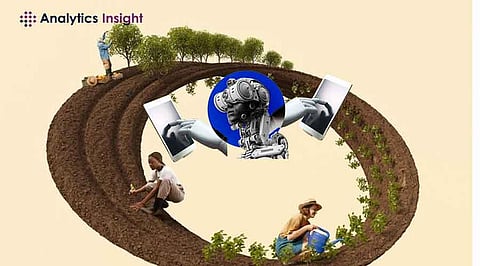

The Indian agricultural sector is transforming fundamentally by incorporating AI. AI in farming is bringing solutions to climate-related challenges, infestation attacks, financial restrictions, etc. Let’s explore in detail how modern AI-powered agriculture technologies are boosting productivity, sustainability, and profitability in terms of outputs.
Agriculture remains one of the core sectors of the Indian economy, adding about 17% to the GDP and employing almost 58% of the working population. However, farmers face many challenges, including irregular weather conditions, reduced yields, and post-harvest losses. The Indian agri-tech market currently stands at about $204 million and is expected to scale much higher with AI technology.
The foray of AI in farming, particularly in the Indian agricultural sector, is bringing about many benefits:
AI technologies aid precision agriculture in which farmers can optimize inputs such as water, fertilizer, and pesticides. Companies like Cultyvate have employed automatic irrigation systems that can help increase yield by 20% when water usage decreases by up to 50%. The system includes sensors that supply the accurate data for soil moisture levels, ensuring appropriate water supply for crops.
AI-driven predictive analytics helps Indian farmers predict weather changes and pest outbreaks. For instance, AI models analyze historical weather data to forecast conditions that may affect crop health. This proactive approach allows farmers to take preventive measures, reducing losses and improving yields.
‘Saagu Baagu’, an AI initiative in Telangana, exemplifies the benefits of AI data management for farmers. It has so far enhanced chili production for more than 7,000 farmers, with a yield increase of 21% per acre and a decrease in pesticide usage of 9%. Based on data analysis and advisory services from AI, farmers' incomes have more than doubled, reaching INR 66,000 ($800) per acre per crop cycle.
AI is also essential for optimizing agriculture supply chains. AI analyzes market trends and consumer demand. This helps farmers decide what to plant, when to sell the crop, etc., maximizing profits while reducing waste in the entire supply chain.
Indian agriculture seems to look bright with the future development of AI technology. Advances in AI are expected to increase the global market for agri-tech by $13.8 billion through 2031. The government's support for digital agriculture initiatives in India will likely boost this growth.
Following the success of projects such as Saagu Baagu, the Indian government aims to reach around 500,000 farmers through its multiple value chains. This represents the scalability of AI solutions in solving various agricultural issues that small-landholder Indian farmers encounter.
Investment in agri-tech startups is increasing because venture capitalists recognize the potential for high returns. Increasing funding and technological advancement will lead to more innovative solutions, empowering farmers with productivity tools.
While there is hope, there are also a few challenges that can slow down the pace of AI adoption by farmers:
Infrastructure gaps: Many areas in the countryside need the right infrastructure for implementing advanced agricultural technologies.
Digital Literacy: Farmers will need training to use AI tools efficiently.
Cost Barriers: The investment cost of technology is high for smallholder farmers, making it impossible for them to utilize AI's benefits in farming.
Therefore, the government, private enterprises, and non-profit organizations must collaborate to overcome these challenges. Digital literacy programs and subsidized access to technology can help expand AI use in agriculture.
AI is playing a pivotal role in transforming agriculture into a sector’s efficiency in maximizing crop output and security. As technologies continue to develop, India stands at the forefront of the agricultural revolution that could set benchmarks for other nations facing similar challenges. Embracing these innovations will improve food security, economic growth, and environmental sustainability in the future.
